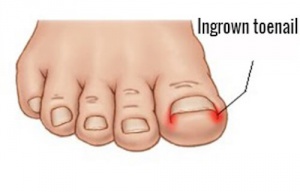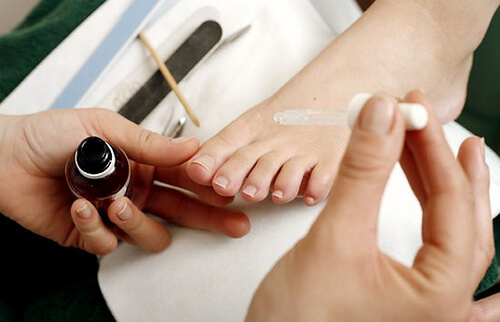How to Naturally Cure Ingrown Toenails

Today, we’re going to talk about the causes, symptoms, and how to naturally cure ingrown toenails. There are some great natural home remedies you can use to treat them. They’re not at all complicated and use common kitchen ingredients: lemon, salt, thyme, onion, egg, and carrot.
What are the symptoms?
It’s easy to tell when you have an ingrown toenail because you can see how the area around the nail looks red and/or inflamed, and is generally painful to touch. In some cases, it can also become infected, and have pus-filled sores.
Possible causes
Ingrown toenails can happen for one, or multiple of the following reasons:
- Excessive nail growth.
- Abnormal nail growth.
- Injury caused by the nail growing into the skin.
- Improper footwear that puts too much pressure on the toes.
- Excessive sweating.
- Injuries
- Skin diseases
Thyme infusion to naturally cure ingrown toenails
Thyme is a medicinal plant with multiple benefits. One of those is that it helps fight inflammation, infections, and can relieve pain. This makes it a perfect remedy for treating ingrown nails.
Instructions:
- Make an infusion with one cup of water and two tablespoons of thyme.
- Boil for five minutes and, once the infusion is warm, submerge the affected toe for 5 to 10 minutes.
- Repeat several times throughout the day.
Lemon and salt
You can make an effective ingrown toenail treatment with just these two simple ingredients.
Instructions:
- Make a small hole in the lemon and add a bit of sea salt to it.
- Stick the affected toe in.
- Leave it for 20 minutes, and do this daily until the ingrown nail is cured.
Both lemon and salt are great disinfectants and inflammation reducers.
Onion poultice
Onion is a great anti-inflammatory you can use to treat multiple diseases. That means it can be very helpful if you’re looking for a natural way to cure ingrown toenails. It’s also very simple.
You might like:
Instructions:
- Boil one onion, and blend it once well cooked.
- Apply the onion to a sterile piece of gauze when still warm.
- Apply the poultice to the affected toe.
- You can cover it with a bandage or surgical tape to make sure that it stays on for at least two hours.
Carrot poultice
All of these remedies are very effective ways to naturally cure ingrown toenails. So, you can choose based on what you have in your kitchen, or you could alternate to see which one works best for you.
Read more:
This poultice, for example, is similar to the onion one, but you use carrots instead. Along with helping to eliminate the ingrown toenail, it also revitalizes affected skin.
Apply three times a day, for at least 15 minutes.
Egg white
This remedy is super quick and also provides great results if you do it until you see improvement. All you have to do is beat one egg white and apply it to the affected area several times a day. You can keep egg whites in the fridge for 3 days.
Can you prevent them?
You can prevent ingrown nails by following this advice:
- Always keep your nails cut and uniformly trimmed, keeping the cuticles in mind too. Always use a file so that you don’t leave any rough edges.
- Avoid wearing socks that are too tight. Instead, choose socks that respect the natural shape of your foot. Make sure they’re breathable. Ideally, you should also avoid high-heeled shoes.
- If you’ve had any kind of injury, like someone stepping on your foot, treat it with natural remedies even if it doesn’t seem severe.
- Moisturize your hands and feet regularly, with creams that contain vitamin E or plant oils.
- If you have had fungus on the affected area, apply a drop of pure tea tree oil every day. It’s a powerful fungicide.

Recommendation: if your toenail is infected and the infection doesn’t go away, stays the same, or gets worse, see your doctor to prevent further complications. This isn’t super common, but it could happen if a nail falls off, an abscess forms, the infection spreads, etc. So, instead of letting that happen, why not cure your ingrown toenails naturally with these remedies?
Photos courtesy of FoundryParkInn
All cited sources were thoroughly reviewed by our team to ensure their quality, reliability, currency, and validity. The bibliography of this article was considered reliable and of academic or scientific accuracy.
- De Berker, D. A. R., André, J., & Baran, R. (2007). Nail biology and nail science. International Journal of Cosmetic Science. https://doi.org/10.1111/j.1467-2494.2007.00372.x
- Cashman, M. W., & Sloan, S. B. (2010). Nutrition and nail disease. Clinics in Dermatology. https://doi.org/10.1016/j.clindermatol.2010.03.037
- Tully, A. S., Trayes, K. P., & Studdiford, J. S. (2012). Evaluation of nail abnormalities. American Family Physician.
- Ahmad, T., Cawood, M., Iqbal, Q., Ariño, A., Batool, A., Tariq, R., Azam, M., & Akhtar, S. (2019). Phytochemicals in Daucus carota and Their Health Benefits-Review Article. Foods (Basel, Switzerland), 8(9), 424. https://doi.org/10.3390/foods8090424
- Klimek-Szczykutowicz, M., Szopa, A., & Ekiert, H. (2020). Citrus limon (Lemon) Phenomenon-A Review of the Chemistry, Pharmacological Properties, Applications in the Modern Pharmaceutical, Food, and Cosmetics Industries, and Biotechnological Studies. Plants (Basel, Switzerland), 9(1), 119. https://doi.org/10.3390/plants9010119
- Nagoor Meeran, M. F., Javed, H., Al Taee, H., Azimullah, S., & Ojha, S. K. (2017). Pharmacological Properties and Molecular Mechanisms of Thymol: Prospects for Its Therapeutic Potential and Pharmaceutical Development. Frontiers in pharmacology, 8, 380. https://doi.org/10.3389/fphar.2017.00380
This text is provided for informational purposes only and does not replace consultation with a professional. If in doubt, consult your specialist.









